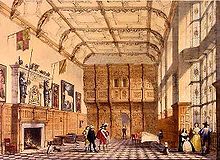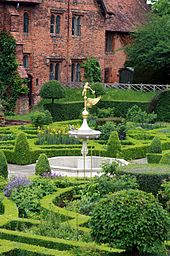" Hatfield House /£3 - 3-0 / Margaret Thompson / Hitchen " on a label
The Summer Drawing Room is one of the rooms in the private quarters of Hatfield House. The portrait attributed to Daniel Mytens depicted is of Lady Anne Cecil and this still hangs in that room. The object on the far left of the painting is in fact a Dutch manual organ, circa 1611. It now sits in the Armoury in Hatfield House.
Hatfield House is a country house set in a large park, the Great Park, on the eastern side of the town of Hatfield, Hertfordshire, England. The present Jacobean house, a leading example of the prodigy house, was built in 1611 by Robert Cecil, First Earl of Salisbury and Chief Minister to King James I and has been the home of the Cecil family ever since. It is a prime example of Jacobean architecture. The estate includes extensive grounds and surviving parts of an earlier palace. The house, currently the home of Robert Gascoyne-Cecil, 7th Marquess of Salisbury, is open to the public.
An earlier building on the site was the Royal Palace of Hatfield. Only part of this still exists, a short distance from the present house. That palace was the childhood home and favourite residence of Queen Elizabeth I. Built in 1497 by the Bishop of Ely, King Henry VII's minister John Cardinal Morton, it comprised four wings in a square surrounding a central courtyard. The palace was seized by Henry VIII with other church properties. The nearby parish church of St Etheldreda's, in Old Hatfield once served the Bishops Palace as well as the village.
Henry VIII's children, King Edward VI and the future Queen Elizabeth I, spent their youth at Hatfield Palace. His eldest daughter, who later reigned as Queen Mary I, lived there between 1533 and 1536, when she was sent to wait on the then Princess Elizabeth, as punishment for refusing to recognise Henry's marriage to Anne Boleyn and his religious reforms. In 1548, when she was only 15 years old, Elizabeth was under suspicion of having illegally agreed to marry Thomas Seymour, the House and her servants were seized by Edward VI's agent Robert Tyrwhit, and she was interrogated there. She successfully defended her conduct with wit and defiance. Seymour was executed in 1549 for numerous other crimes against the crown. After her two months of imprisonment in the Tower of London by her sister Queen Mary, Elizabeth returned to Hatfield. The Queen Elizabeth Oak on the grounds of the estate is said to be the location where Elizabeth was told she was Queen following Mary's death, but is considered unlikely as Mary died in November. In November 1558, Elizabeth held her first Council of State in the Great Hall. Hatfield House is a popular tourist attraction because it has so many objects associated with Queen Elizabeth I, including some gloves and a pair of silk stockings that are believed to have been the first ones in England. The library displays a 22 feet (6.7 m) long illuminated parchment roll showing the pedigree of the Queen with ancestors back to Adam and Eve. The Marble Hall holds the "Rainbow Portrait" of Elizabeth.

Elizabeth's successor, King James I, did not like the palace much and so gave it to Elizabeth's (and his own) chief minister Robert Cecil, 1st Earl of Salisbury in 1607, in exchange for Theobalds Palace which was the Cecils' family home on the current site of Cedars Park, Broxbourne. Cecil, who liked building, tore down three wings of the royal palace (the back and sides of the square) in 1608 and used the bricks to build the present structure. The richly carved wooden Grand Staircase and the rare stained glass window in the private chapel are among the house's original Jacobean features.
Cecil's descendant, Robert Arthur Talbot Gascoyne-Cecil, 3rd Marquess of Salisbury, was three times prime minister during the closing years of Queen Victoria's reign. The city of Salisbury (now Harare) in the colony of Rhodesia (now Zimbabwe) was founded in his time, and named for him. He is also known for often putting members of his family into the Government while Prime Minister. As his first name was Robert, this habit is sometimes said to have given rise to the popular expression 'Bob's your uncle' (meaning roughly 'It's all right, everything is sure to come off')
During World War II, Hatfield house was the location of the first Civil Resettlement Unit, and acted as Headquarters for the scheme. CRUs were created to help repatriated British prisoners of war to transition back to civilian life, and the luxurious setting of Hatfield was considered very beneficial to these men. On 12 July 1945, the King and Queen visited the CRU at Hatfield, which generated significant news coverage.
Gardens
The Gardens, covering 42 acres (170,000 m²), date from the early 17th century, and were laid out by John Tradescant the elder. Tradescant visited Europe and brought back trees and plants that had never previously been grown in England. The gardens included orchards, fountains, scented plants, water parterres, terraces, herb gardens and a foot maze. They were neglected in the 18th century, but restoration began in Victorian times and continues under the present Dowager Marchioness of Salisbury.
During World War I, the grounds were used to test the first British tanks. An area was dug with trenches and craters and covered with barbed-wire to represent no man's land and German trench lines on the Western Front. To commemorate this, the only surviving Mark I tank was sited at Hatfield from 1919 until 1970 before being moved to The Tank Museum, Bovington.
Figure , landscape and flower painter. Hitchin, Herts, 1883, Hereford 1915, exhibited, RA, B, RBA, RI, RSA and SWA.




